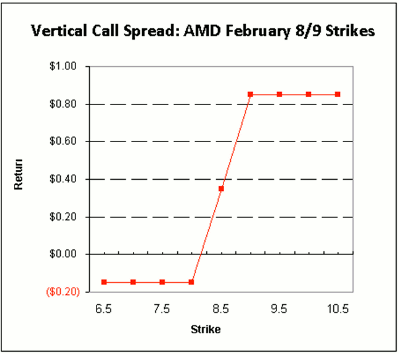After the close last Thursday night, Advanced Micro Devices Inc. (AMD) posted Street-beating fourth-quarter earnings and revenue, but the stock dropped nearly 6% the day after, Friday. Investors seemed to be expressing some anxiety about AMD's future following the unexpected resignation of CEO Dirk Meyer earlier in the month.
These developments brought on a wave of put volume, with more than 7,200 of these typically bearish contracts changing hands last Friday, more than quadrupling the stock's average daily put volume. However, one option trader shrugged off the uncertainty, choosing to open a bullish spread on the security.
Specifically, 138 February 8 calls traded at about 11:54 am ET on the International Securities Exchange (ISE). These contracts crossed at the ask price of $0.20, or $20 per contract, and were marked "spread." At the same time, 138 February 9 calls, also marked "spread," changed hands for the bid price of $0.05, or $5 per contract.
The end result is a vertical call spread, more commonly known as a debit spread, on Advanced Micro Devices. This options strategy is also known as a long call spread, or a bull call spread.
The Anatomy of an Advanced Micro Devices Bull Call Spread
Breaking down this debit spread position, the trader purchased 138 February 8 calls for the ask price of $0.20, resulting in a debit of $2,760 [(0.20 x 100) x 138]. In the absence of the premium received by selling the February 9 call, the trader would need AMD to rally roughly 8.2% from Friday's trading range near $7.58, to $8.20 per share, in order for the position to reach breakeven at expiration. Furthermore, the maximum loss on this leg of the position is limited to the initial investment of $2,760.
As you can see, the second leg of the debit spread helps to offset the cost of the overall position. In this case, the trader sold 138 February 9 calls for the bid price of $0.05, netting a total credit of $690 [(0.05 x 100) x 138]. Combining this leg of the trade with the purchased February 8 calls lowers the total cost of the entire position to $2,070 ($2,760 - $690).
The maximum profit is calculated by subtracting the premium paid from the difference between the two strikes, and is reached if AMD rallies to $9 per share at expiration. In this case, the maximum profit is $0.85 [(9 - 8) - 0.15], or $85 per contract. The maximum loss is equal to the net debit of $0.15, or $15 per contract. Below is a chart for a rough visual representation of the trade's profit/loss scenario:
Implied Volatility
After the vertical call spread has been entered, increasing implied volatility is pretty much neutral to the overall position, as it lifts the value of both the sold option and the purchased option. At the time of the trade, implied volatility, or “implieds,” for the February 8 call arrived at 39.93%, while the implied volatility for the February 9 call came in at 45.31%. For comparison, AMD's one-month historical volatility arrived at 44.37% as of the close on Thursday.
By Joseph Hargett, contributor, Schaeffer’s Trading Floor Blog
























